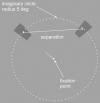The gap effect is exaggerated in parafovea
- PMID: 16961988
- PMCID: PMC2648725
- DOI: 10.1017/S0952523806233327
The gap effect is exaggerated in parafovea
Abstract
In central vision, the discrimination of colors lying on a tritan line is improved if a small gap is introduced between the two stimulus fields. Boynton et al. (1977) called this a "positive gap effect." They found that the effect was weak or absent for discriminations based on the ratio of the signals of long-wave and middle-wave cones; and even for tritan stimuli, the gap effect was weakened when forced choice or brief durations were used. We here describe measurements of the gap effect in the parafovea. The stimuli were 1 deg of visual angle in width and were centered on an imaginary circle of radius 5 deg. They were brief (100 ms), and thresholds were measured with a spatial two-alternative forced choice. Under these conditions we find a clear gap effect, which is of similar magnitude for both the cardinal chromatic axes. It may be a chromatic analog of the crowding effect observed for parafoveal perception of form.
Figures








References
-
- Bouma H. Interaction effects in parafoveal letter recognition. Nature. 1970;226:177–178. - PubMed
-
- Boynton RM, Hayhoe MM, MacLeod DIA. The gap effect: Chromatic and achromatic visual discrimination as affected by field separation. Optica Acta. 1977;24:159–177.
-
- Cottaris NP, De Valois RL. Temporal dynamics of chromatic tuning in macaque primary visual cortex. Nature. 1998;395:896–900. - PubMed
-
- Dacey DM, Lee BB. The “blue-on” opponent pathway in primate retina originates from a distinct bistratified ganglion cell type. Nature. 1994;367:731–735. - PubMed
Publication types
MeSH terms
Grants and funding
LinkOut - more resources
Full Text Sources
Miscellaneous

